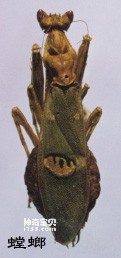[Economic Significance] The mantis has a unique shape. Its head is as broad as a horse's head, and its front feet are shaped like a crescent knife. When it is still, it seems to be praying, and when it moves, it is as fast and fierce as a tiger running. In order not to attract the attention of prey, mantises have unique mimicry. The wide ones are like green leaves and red flowers, and the thin ones are as long as bamboo leaves. Therefore, praying mantises have always been loved by people. Both adults and nymphs are predatory and feed on other insects and small animals. They are famous natural enemy insects. The eggs laid by mantises are surrounded by ootheca, which is called mantis. It can be used in traditional Chinese medicine and is an important medicinal resource insect.

[Identification points] Body length 10-140 mm. The head is large and triangular; the mouthparts are chewing; the antennae are long and of different shapes, mostly filamentous, and a few are rosary-shaped or other shapes. The forechest is long and the forefoot is catching. The forewings are covered, the hind wings are membranous, and the rump area is large. They lie flat on the back when resting. 1 pair of tail whiskers. There is a pair of spines on the 9th abdominal plate of males. Gradual metamorphosis. The egg sheath is attached to branches or walls.
[Species and Distribution] There are more than 2,200 known species in the world, distributed in most areas of the tropics, subtropics and temperate zones. my country has recorded 112 species in 8 families, 19 subfamilies, 47 genera. Common ones include Chinese mantis and so on.
The characteristics of this order can be summarized as follows: the mantis prays with its legs curled up, and it swings its arms like a car as fiercely as a tiger; its head is like a triangle with large compound eyes, and its chest is extended to capture its feet.
[Biological learning] Praying mantises have ferocious and aggressive habits, and they often kill each other even if they are of the same kind. Not only does the big one eat the small one, but also the female eats the male. This is a normal phenomenon, so some people call the male praying mantis the "infatuated husband." When mantises are mating, the female mantis sometimes turns around and bites the head of the male mantis first, and then eats the whole body in one mouthful. The male mantis does not make any resistance and allows him to do whatever he wants. It sounds cruel, but in fact, after mating, the female praying mantis urgently needs a lot of nutrients to form the eggs in her belly and to produce a large amount of gelatinous material to wrap the eggs when she lays eggs in the future. The male mantis is dedicated to his children.
A female mantis can generally lay two or three egg masses, and one egg mass contains dozens to hundreds of eggs. Because the eggs are protected by a harder egg sheath, they can survive the winter safely. When the weather gets warmer next year, a new generation will be born.
When the little mantis is born, it can take the membrane coat inside the egg out of the sheath, and then it hatches out of the egg and hangs the thread. The ones that hatch first move up the thread; they leave the egg sheath and fend for themselves. This prevents brothers and sisters who are naturally carnivorous from killing each other. Such ingenious arrangements are probably also the instinct of biological intelligence.
animal tags: mantis
We created this article in conjunction with AI technology, then made sure it was fact-checked and edited by a Animals Top editor.